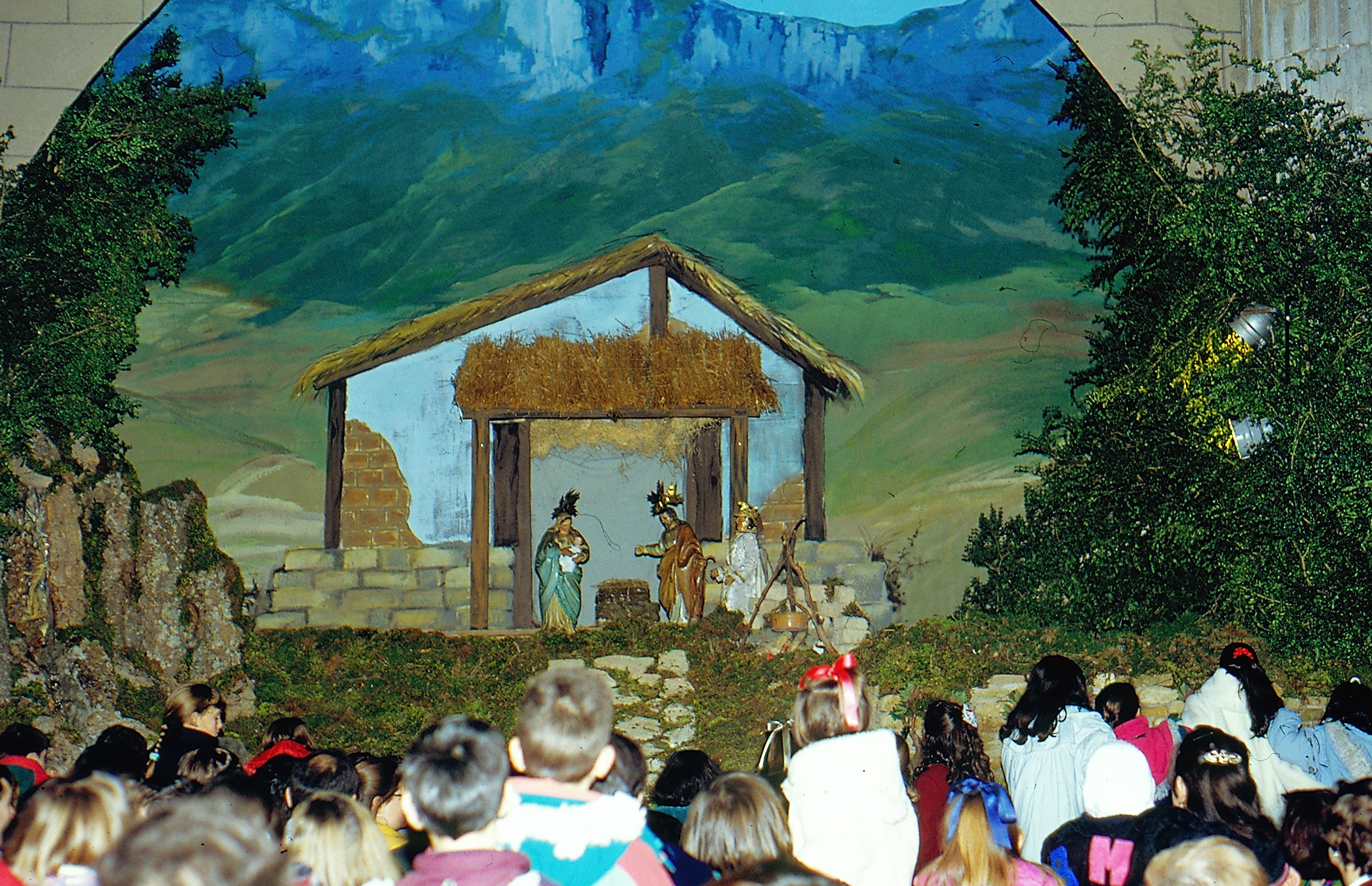Basque ethnography at a glance

Children entertained by the performance of the Nativity of Jesus. Laguardia (Álava), 1994. José Ángel Chasco.
The first representation of the birth of Jesus is attributed to Saint Francis of Assisi in the year 1223. During the 14th century the practice became widespread across the south of Italy. In the 18th century Charles III made the Nativity tradition popular in Spain and Spanish territories.
The Nativity scene of Laguardia forms part of the cultural wealth and religiosity of the local people during the Christmas season. It is of great historic and ethnographic interest.
Performances of four Christmas stories are presented: the Nativity of Jesus and the Adoration of the Shepherds on Christmas Day; the Circumcision, on New Year’s Day; the Adoration of the Three Kings of Orient, on Epiphany; and the Flight into Egypt, at the beginning of February, after St Blaise’s Day (3 February). Featuring the theatrically staged story of the miracle of the wheat field, the latter is the most beautiful and funniest out of the four performances, and that which attracts the biggest audience.
An image of Saint Blaise surrounded by traditional rosquillas is placed to the right of the main altar, and another of Mary to the left among yet more rosquillas and a cage with pigeons symbolizing the Presentation of Jesus in the Temple at Candlemas, also known as the feast of the Purification of the Blessed Virgin Mary (2 February).
It is the longest lasting Nativity scene over the Christmas period. Theatre performances begin on Christmas Day and continue until the first Sunday in February. Seasoned with music by bagpipers, all four stories will be enacted in one afternoon around the second half of January. Events are organized by the Association of the Nativity at Our Lady of the Kings in Laguardia.
The Nativity plays are performed in the chapel of the Immaculate Conception following high mass at the parish church. It is also an opportunity to admire the most precious jewel in the crown of Laguardia, namely the polychromatic Gothic portico at Our Lady of the Kings.
The dancing shepherds and the charge of the rams liven up and add excitement to the four plays. The shepherds from the Nativity dance in a circle to the frantic sound of the bagpipes and drum. Suddenly pairs of dancers start bumping into each other. The blows they receive are sometimes hard enough to disfigure them and cause significant damage. These acts come as a surprise to the audience and prompt an explosion of hilarity and laughter. Two rams, in turn, rear up on their hind legs and crash their horns together violently, strong and keen, with a heavy thud accompanied by the deep ringing of the bells hanging from their heads. Dancers and rams are sure to delight the little ones, who love and enjoy the show.
The staging of the sacred drama offers an enjoyable sound and light display. This in Laguardia is a Nativity scene with moving figures, scenic design and the music of pipes and drum. Large numbers of children attend the plays and have fun watching the animated Nativity. Under the stage participants and collaborators move the articulated pieces sliding boards and operating the figures with simple mechanisms.
Since the mid-18th century the Nativity performances have been integrated into the Christmas liturgy. This animated Baroque Nativity exhibits 73 pieces. The main characters of the plays range from multicoloured wood sculptures in the round to dressed images, papier mâchier figures and wooden cut-out silhouettes. The latest records about the Nativity of Laguardia go back to 1749 and show the cost of the altar.
The year 1761 was a key date for the enlargement of the Nativity, for it was completed with the articulated figures of the Adoration of the Shepherds, Circumcision of Jesus, Adoration of the Three Kings, dance of the shepherds and ram fighting. The wheel that serves to move the dancing shepherds and perform the sowing of the wheat field dates from 1783.
Performances and biblical texts (both canonical and apocryphal Gospels) provide doctrinal teaching comparable to catechism. The four plays complement the liturgy and provide the faithful with an illustration of scenes from the life of Jesus the Child.
José Ángel Chasco – Etniker Álava – Etniker Euskalerria Groups
Translated by Jaione Bilbao – Language Department – Labayru Fundazioa
References for further information: Miguel Martínez Ballesteros. El Libro de Laguardia [The Laguardia Book]. 1887; and Clara Isabel Ajamil & Francisco Javier Gutiérrez. El Belén de Santa María de los Reyes de Laguardia (Álava). Un Belén barroco de movimiento [The Nativity scene at Our Lady of the Kings in Laguardia (Álava). An animated Baroque Nativity]. 2004.


